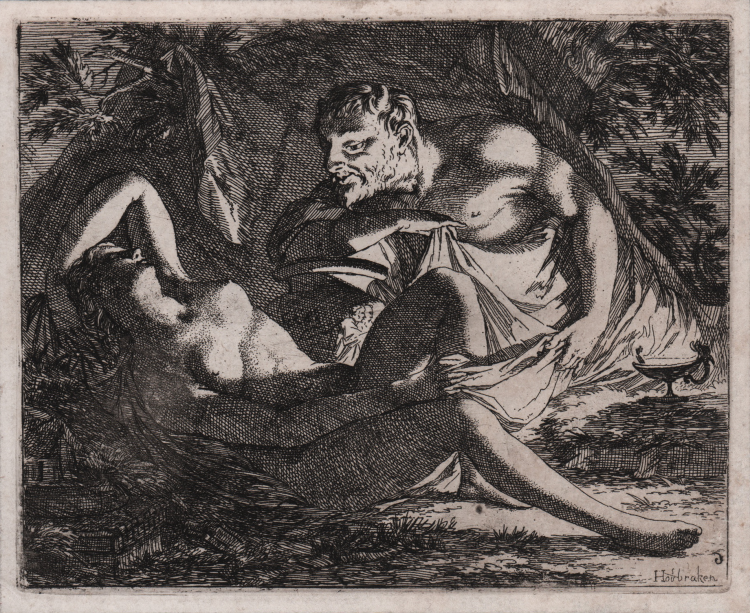



| Reference: | S45369 |
| Author | Arnold HOUBRAKEN |
| Year: | 1699 ca. |
| Measures: | 147 x 120 mm |


| Reference: | S45369 |
| Author | Arnold HOUBRAKEN |
| Year: | 1699 ca. |
| Measures: | 147 x 120 mm |
Satyr and a nymph in a landscape; nymph sleeping on the left; a satyr is leering at her and draws her sheet away.
Plate from the series "Toneel van Sinnebeelden Geopent/Tot dienst van Schilders, Beeldhouders etc door A. Houbraken .II. Deel"; second part of a series of figures depicting emblems and symbols.
Etching, circa 1699, signed at lower right.
A fine impression, printed on contemporary laid paper with thin margins, very good condition.
Arnold Houbraken (28 March 1660 – 14 October 1719) was a Dutch painter and writer from Dordrecht, now remembered mainly as a biographer of Dutch Golden Age painters. Houbraken was sent first to learn threadtwisting from Johannes de Haan, who introduced him to engraving. He then studied with Jacobus Leveck and finally, four years with Samuel van Hoogstraten. Arnold Houbraken painted mythological and religious paintings, portraits and landscapes. He is best known for the art historical work The Great Theatre of Dutch Painters (1718–1721).
Rare.
Bibliografia
Hollstein / Dutch and Flemish etchings, engravings and woodcuts c.1450-1700 (undescribed).
Arnold HOUBRAKEN (Doordrecht 1660 - Amsterdam 1719)
|
Arnold Houbraken (28 March 1660 – 14 October 1719) was a Dutch painter and writer from Dordrecht, now remembered mainly as a biographer of Dutch Golden Age painters. Houbraken was sent first to learn threadtwisting (Twyndraat) from Johannes de Haan, who introduced him to engraving. After two years he then studied art with Willem van Drielenburch, who he was with during the rampjaar, the year 1672. He then studied 9 months with Jacobus Leveck and finally, four years with Samuel van Hoogstraten. In 1685 he married Sara Sasbout, and around 1709 he moved from Dordrecht to Amsterdam. Arnold Houbraken painted mythological and religious paintings, portraits and landscapes. He is best known for the art historical work The Great Theatre of Dutch Painters (1718–1721). When he died his son Jacob assisted his mother with the last proofs of the manuscript before publishing. His first attempt at an instructive manual for artists was his Emblem book, Inhoud van 't Sieraad der Afbeelding, which was meant as a guide of possible painting themes. His registered pupils were Matthijs Balen, Johan Graham, and his son Jacob.
|
Arnold HOUBRAKEN (Doordrecht 1660 - Amsterdam 1719)
|
Arnold Houbraken (28 March 1660 – 14 October 1719) was a Dutch painter and writer from Dordrecht, now remembered mainly as a biographer of Dutch Golden Age painters. Houbraken was sent first to learn threadtwisting (Twyndraat) from Johannes de Haan, who introduced him to engraving. After two years he then studied art with Willem van Drielenburch, who he was with during the rampjaar, the year 1672. He then studied 9 months with Jacobus Leveck and finally, four years with Samuel van Hoogstraten. In 1685 he married Sara Sasbout, and around 1709 he moved from Dordrecht to Amsterdam. Arnold Houbraken painted mythological and religious paintings, portraits and landscapes. He is best known for the art historical work The Great Theatre of Dutch Painters (1718–1721). When he died his son Jacob assisted his mother with the last proofs of the manuscript before publishing. His first attempt at an instructive manual for artists was his Emblem book, Inhoud van 't Sieraad der Afbeelding, which was meant as a guide of possible painting themes. His registered pupils were Matthijs Balen, Johan Graham, and his son Jacob.
|